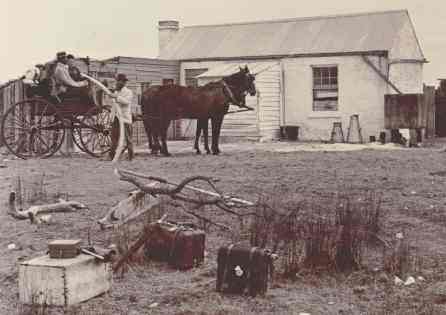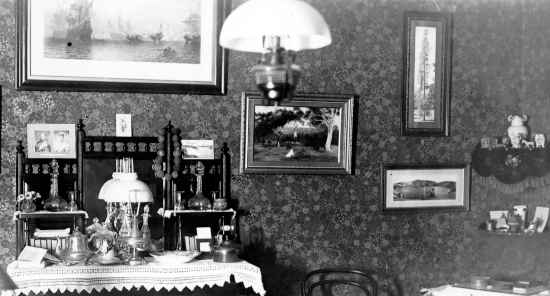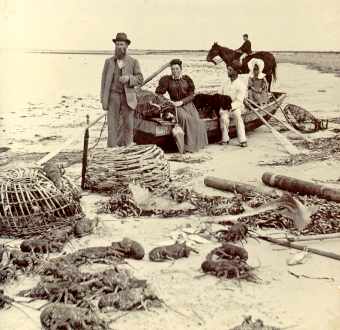
1898 - Around Mount Gambier and Cape Banks.
Henry Tilbrook’s old friend Fred Lester was promoted to the position of manager of the Amp office at Mount Gambier and invited Henry to come down ‘for an outing.’ Henry left Adelaide on 16 February 1898. ‘My beloved Marianne accompanied me to the Adelaide Railway station and kissed me goodbye. She watched the train while it was in sight. I gazed upon her loved form till no longer in view, and was sad. But the parting was to be for not more than one month, and that period of time would soon slip by. Fifteen hours later the train pulled into the Mount Gambier railway station.
Henry wrote in his reminiscences, ‘I took with me several dozen photographic dry-plates, a whole-plate camera by Thornton and Pickard, stigmatic and stereoscopic lenses by Dallmeyer, with Burchett color screens, and thus had a heavy load.’
Henry walked around Mount Gambier looking for subjects for his camera. ‘Using Isochromatic Plates and Burchett color screens I took eight views of the extinct craters (and) that night I had to put my head in the ruby bag, change plates and pack others, which took a couple of hours.’
The next day he ‘again walked to the Mount and took eight more pictures, amongst them a telephotographic view of Mount Schank with a fifty inch focus. This means that Mount Schank was brought seven times nearer the camera - or that the picture was enlarged on the plate to that extent. A seven-inch lens would have represented normal. Although tired with my day’s trudge, and my load, which weighed thirty-seven pounds, I enjoyed myself greatly, the scenes being so new and interesting to me.’
Henry’s friend Fred Lester had rented a "Cottage-by-the-Sea" at Cape Banks for a fortnight, and they travelled there in a four-wheeled trap. The party consisted of Mr and Mrs Lester, Henry, their daughter Dorothy and a boy called Leslie. They reached the cottage after dark and waited for their provisions cart which was coming on separately.
The cottage (see photograph below) had not been occupied for six months and was smelly and "holey". There were holes in the board floor, in the door, and in the holey hessian ceiling which sifted sand on them and their food every day. The airbricks at floor level were broken and ‘snakes could crawl in and out whenever they chose. There was a window in each of the (two) rooms. A pair of sashes was shared between the two windows. One half was nailed to the top of each window frame, and the bottom halves of the openings were filled up with palings nailed across, with plenty of openwork between each. The two doors of the house (like a Bush hut there was no back door) came from the wreck of some ship. One of them had the number of the cabin painted on it. There was another little side room outside, made of palings. But it was so fully inhabited that none of us dared go inside it. Nevertheless, the Cottage-by-the-Sea was quite a little palace, for it had a good iron roof that did not leak.’
28 February 1898 - ‘I strolled a couple of miles down the beach, southwards. Wreckage in abundance lay about the shore everywhere. I picked up a piece of whale rib measuring six feet in length. In one of my photos, showing our party in the trap, ready to start from the Cottage-by-the-Sea, I am seen holding it up with one hand, the end resting on the sand. With the other hand I am winding up a reel of thread which sets the shutter of the camera in motion and exposes the negative.’
Below: Henry Tilbrook holding the whale rib at the Cottage-by-the-Sea. Enlarged section of one frame of a stereo pair.

Henry often worked alone, carrying his camera equipment for miles in search of a suitable subject, and for this reason not many of his views of scenery include a human figure. The exception was when he used his long thread to capture himself in the photograph. On one occasion a Mr and Mrs Pile and family living nearby joined them on the beach. ‘I asked them to stand as subjects in my views and they did so without the slightest hesitation, thereby adding greatly to the artistic value of the pictures and giving them an additional interest. Of course it blew a gale the whole day which made photography difficult. In a view of (one of the Blackfellow’s Caves) one of the ladies in the picture is having a desperate struggle to keep her hat on. One tall girl in a short dress was very plucky and offered to stand in some most dangerous places to add piquancy to the views. She offered to stand on the extreme points of the overhanging rocks but I would not permit it.’
Mr & Mrs Lester, Dorrie, Leslie and Henry started for the nearby Blackfellow’s Caves -- ‘On the way I noticed some rocks projecting into the sea with an archway in one portion, forming a natural bridge. I accordingly left the trap and stayed there to take a photograph of it. I had now a Thornton Pickard camera with Dallmeyer lenses - four of them. To the shutter I had attached an invention of my own, by which I could take views while standing any distance away from the camera. Thus, when alone, in order to put life into the picture or for a matter of comparison to show the relative size of things I generally stood in the foreground myself. I simply wound up a reel of thread held in one hand which could be done without showing any movement in the picture. The tightening of the thread set the shutter of the camera in motion and the photo was taken while I was yards away. I could give an exposure of from one-quarter of a second to the ninetieth part of a second at will. I placed the thread in such a way that it never showed in the picture. Through this simple little contrivance I was independent of other people. And I could also make one of any group that would have been incomplete without me. To eliminate any shaking of the camera if the thread was wound up too roughly I used a one-ounce Martini-Henry rifle bullet with a hole bored in it. This bullet, after doing its work, fell to the ground detached and thus no vibration of the camera was ever set up, no matter how hard the thread was pulled, because the thread was attached to the bullet and I could drag the bullet right up to me if I chose… Having focussed, put the dry plate into position, adjusted the shutter, and laid the reel of thread around the cliff and rocks and seashore by the aid of little wire pegs which I carried with me for that purpose, I stood on the top of the archway and wound up the thread. I heard the click of the shutter and knew that the photo was taken.’
 |
CORSET ROCK. In 1898 Henry Tilbrook photographed himself on a rock which he called Corset Rock. In this half of his stereo pair the rock and its reflection have the appearance of the ‘wasp waist’ made by the corsets women wore in the 19th century. To take this photograph of himself on the rock Henry used his usual long thread technique which he has described in the text above this picture. (Corset Rock text below) |
Henry photographed a number natural features along the coast. One of these, he wrote, was ‘that peculiar formation which I named Corset Rock in honour of the ladies. When Marianne saw the photo, she wished to know how I climbed the rock. It certainly was a difficult object to photograph. I went to it on four different occasions and found the conditions unfavourable.
‘The last time, I fixed the camera in about two feet deep of sea water and having adjusted everything, flung the reel of thread on top of the rock and climbed up myself. I had no boots on of course, being in the sea. But when I got to the top I found the rocky spikes so sharp that I could not move. Accordingly I had to descend and put my boots on. Then I climbed up again, wound up the thread and took the view. That occurred in 1898. Afterwards, in 1920, I saw that photograph in railway carriages wherever I travelled. (Note -- In 1901 Henry Tilbrook supplied the Railways Department with enlarged copies of photographs taken on this trip which were use to decorate railway carriages.)
‘One lady of our acquaintance,’ Henry wrote, ‘was going up north in the train and got out at the Burra. Going home to her people she said, "I came up in a carriage with Mr Henry Tilbrook."
"Did you? Where was he going?" she was asked.
"I don’t know," was the reply. ‘I left him in the train. He was sitting on a rock – in a picture." ’
--------------
‘I was out every day and all day taking photographs of this romantic coast. I made use of the isochromatic process in which colored screens are interposed between the lens and the plate. There were three different screens - two Burchett’s and one Ilford. The former consists of two glass planes -- one yellow, the other green -- mounted together in optical contact; the Ilford of a single yellow plane. The extra exposure required ranged from four times extra to fifteen times extra. These screens eliminated the blue light rays; thus preventing halation and rendered distant objects such as mountain ranges as clearly as near ones. In addition to these modern scientific appliances to obtain clear photographs I had both high-power and low-power Dallmeyer telephotographic lenses with dark and light Burchett color screens. These represented lenses with foci from seven and a half inches up to sixty-six inches. The latter focus brought distant objects very, very close, but required an enormous exposure - as much as four and a half minutes with a dark Burchett screen when stopped down to clearness; and double that if late in the afternoon. Thus it was almost impossible to use these important lenses in windy weather. And when is it not windy when you go out to take views! Many a time I have had my camera rise into the air like a bird when I took my hand off it for a second - and it was a whole-plate camera, too, and no light weight.’
Henry took several photographs of the Cape Banks lighthouse, and was well-received by the people working there. ‘They all assisted me in every way in taking views and gave me all the information about the locality that I desired. The ladies at the head keeper’s house kindly took in their washing from the clotheslines at my request while I photographed the two cottages.’ When Henry returned to Adelaide he sent each of the families at the lighthouse a full set of photographs he had taken there.
Below: "A Hatter's Camp near Cape Banks." From Henry Tilbrook's postcard.

Henry broke his umbrella while at Cape Banks but managed to mend it. ‘I had always to carry an umbrella to protect the camera from the wild, wild winds that are ever blowing when you are out taking photos. I did not take my rifle with me on this expedition as I found I could not hunt and take photos too.’
After returning to Mount Gambier Henry and Fred Lester prepared for a trip to the Glenelg River, over the border in Victoria. After they reached the river Henry discovered that he had left a dozen whole plate negatives at Mount Gambier, which meant he could take no more large views. ‘Fortunately I had some whole plates (8½ x 6½ inches) which I had cut into halves longwise making 8½ x 3¼ inch size and they made lovely panoramic views. These I afterwards enlarged into very interesting bromide pictures of the river showing many reaches, the waterway, cliffs, trees and shrubs.’
Below: Henry Tilbrook also used the halves of his whole plate glass plates to photograph tall thin subjects such as trees. Here, at the right of this photograph of the wall of his home at East Adelaide, can be seen a tall slim pine tree photographed in this way with his camera on its side. A number of these narrow negatives have survived. Below this picture on the wall is a two-piece panorama of the Blue Lake, Mount Gambier.

While Henry’s mates were doing some ‘strenuous fishing’ he spent his time taking photos and exploring alone or, as he usually wrote, he went ‘solus’.
14 March 1898 ‘On this day I shouldered my thirty-eight pounds’ weight of photographic apparatus and marching two and a half miles onward and to and through the town took six more views of Mount Gambier and the volcanic lakes. The wind blew almost a hurricane. I wanted a calm, still day, but did not get it! I had an umbrella to protect the camera. The wind, however, had a bad habit of getting around that and shaking up the camera. Some telephotographic views require an exposure of over five minutes. A still atmosphere would have made things easy. While taking a telephotographic view of that extinct cone named Mount Schank from across the Valley Lake the wind blew my camera, lens and heavy stand clean over… I succeeded eventually in taking the view; but the picture was not as sharp as it would have been under more favourable conditions. In fact it was of the fuzzy order of photography - a thing to be avoided and shunned, even banned.’
This last sentence, in italics, probably explains why Henry Tilbrook’s name is not seen on the membership list of the South Australian Photographic Society, which at that time had members who were prominent in the field of ‘pictorial’ photography, or as the ‘f.64’ people who liked sharp, distinct photographs called it, the ‘fuzzy’ photography.
Henry Tilbrook returned to Adelaide by train, where ‘a pair of soft, loving arms were flung around my neck, and I was a happy man once more. My dear one told me how nervous she had been all the time I was absent.
‘Now began the development of negatives, the spotting and touching up of the same, the printing of prints, and the making of bromide enlargements. All the stereoscopic photos, too, had to be printed on silver prints, and toned with gold, mounted on card, and burnished. I always got dear Marianne to help me in fixing the prints in the hyposulphite of soda - a messy job! But she never complained. Fifty prints a day she would fix for me without a murmur. And whenever I went to town she would change the washing water for me every ten minutes. I always sent the partners of my trips copies of each photo that I took on every expedition. On this occasion I had taken no less than seventy-six views - a certain number of them being stereoscopic. My friend, Mr Fred Lester, always got his share, which he much appreciated. Needless to say, printing, enlarging, mounting, filling of albums, and printing of postcards took many months to complete.’
 |
Left: Henry Tilbrook called this picture "Spoils of the Ocean, nr. the Cottage-by-the Sea." One frame of a stereo pair. In the picture, as usual, his right hand is winding up the reel of long thread which triggers the shutter on his camera. |
END.